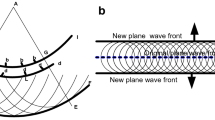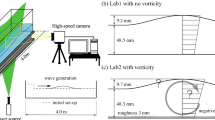Abstract
THE observations described in the striking experiment of Hubbard and Loomis (NATURE, Aug. 6, 1927, p. 189) are another example of the important conclusions which may be derived from a study of the interesting phenomenon of ultrasonic stationary waves. Velocities of sound in various, liquids were determined here by the ultrasonic stationary wave method some years ago; some of these results have already been published (Trans. Roy. Soc. Can., 3, 141; 1923; 159, 191, 197; 1925; 79; 1927); others were reported to the Canadian Research Council (Report, Boyle and Morgan, 1924). The ‘detector’ of the standing waves in these experiments was ‘nodal dust figures,’ something like the figures in a Kundt's tube, but less precision was claimed for the results than is claimed by the authors above.
This is a preview of subscription content, access via your institution
Access options
Subscribe to this journal
Receive 51 print issues and online access
$199.00 per year
only $3.90 per issue
Buy this article
- Purchase on Springer Link
- Instant access to full article PDF
Prices may be subject to local taxes which are calculated during checkout
Similar content being viewed by others
Author information
Authors and Affiliations
Rights and permissions
About this article
Cite this article
BOYLE, R. Ultrasonic Stationary Waves. Nature 120, 476–477 (1927). https://doi.org/10.1038/120476b0
Issue Date:
DOI: https://doi.org/10.1038/120476b0
This article is cited by
-
Investigation of accumulation and persistence time of ultrasonic striation grating of starch suspensions in liquids
Il Nuovo Cimento (1959)
-
Ausbreitungsgeschwindigkeit ultraakustischer Schwingungen in zylindrischen Stäben
Zeitschrift für Physik (1932)
Comments
By submitting a comment you agree to abide by our Terms and Community Guidelines. If you find something abusive or that does not comply with our terms or guidelines please flag it as inappropriate.



